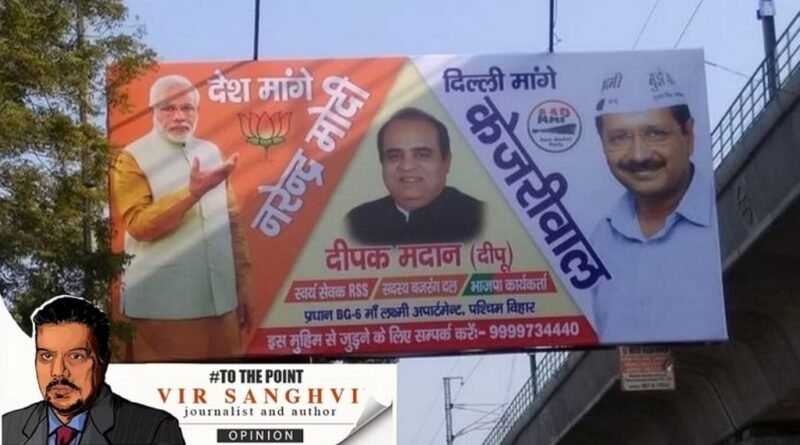Indira Gandhi began it, now Modi, Kejriwal swallow taxpayer money for self-promotion
If by spending hundreds of crores of public money on advertising, political leaders could guarantee their own popularity, then they would never lose elections.
December 15 dmanewsdesk: Do you want to know where your tax money goes? Well, earlier this week, the Narendra Modi government told the Lok Sabha that ever since it came to power, Bharatiya Janata Party had spent Rs 6,491.56 crore on advertising. Of this, Rs 3,260.79 crore went on ads in the electronic media and Rs 3,230.77 crore in print media.
It is not my intention to target the BJP alone for this expenditure: taken on a per capita basis, many non-BJP state governments have also been spending huge amounts on ads. Nor is this the first government at the Centre to spend hundreds of crores on advertising. Besides, taken on a year-by-year basis, the Centre has been reducing its expenses in recent years.
State governments, however, continue to charge ahead. Everyone in Delhi knows that for many years, Arvind Kejriwal was the city’s biggest TV star. Even when there were legal complications about his paid-for stardom, the great man continued to make TV appearances, some of which only featured his back: so recognisable had his body become to the city’s TV viewers that perhaps some were actually glad to see the back of him.
An RTI (Right to Information Act) response earlier this year revealed that the Delhi government spent Rs 488.97 crore on advertising in the financial year 2021-22. Of this, a staggering Rs 125 crore was spent in a single month (March). Obviously, they like the idea of spending public money on promoting themselves.
Do govt ads serve a public purpose?
I mention the Centre and Delhi examples because I live in the capital and see the expenditure first-hand. But the same is true of nearly every other state. Hundreds of crores of public money are spent on banal hoardings carrying the chief minister’s face, and taxpayers’ funds are used to purchase full-page ads (sometimes even the front page) in newspapers.
Often, there is no public purpose to these ads. A Congress-ruled state government will spend crores on ads in other states on Rajiv Gandhi’s birth anniversary. When J. Jayalalithaa was Chief Minister of Tamil Nadu, she plastered her face on nearly every hoarding and newspaper.
To be fair, some of this does serve a public purpose. If a government spends money on public health advertising (which the Centre, to its credit, did during the Covid-19 pandemic), then I can understand the logic. And yes, it is often the duty of information departments at the Centre and in the states to put out ads that convey public service messages. (Though why it is necessary to include pictures of ministers in public service ads is less clear.)
My concern is with unnecessary advertising done mostly to promote individual politicians. You will have noticed that just before an election, ads featuring the state’s political leaders or boasting about the government’s achievements begin appearing with terrifying regularity. Usually, the ads stop just before the Model Code of Conduct kicks in, but it is quite clear that the government in power has used our money to try and improve its own prospects.
How state govts justify huge ad budgets
Many state governments offer various defences. One common argument, which is not without merit, is that the Centre uses pictures of the Prime Minister and ministers everywhere, and government-controlled media is used to promote the Centre’s achievements. For instance, I was at a Rajasthan airport a few days ago, and the screen that was displaying flight timings kept breaking away from the schedules to run visuals celebrating India’s presidency of the G20; a laudatory achievement but not exactly the information that passengers were looking for.
State governments use this sort of promotion of the Centre’s achievements to justify their huge ad budgets. How can we fight this official media barrage at the unlikeliest of places, they argue, if we don’t place our own ads?
Another argument is that mainstream media (both print and electronic) is in the pocket of the ruling party and is so heavily supportive of the government that a non-BJP party cannot get its message across through regular editorial coverage. This is not terribly convincing, especially when it comes from Aam Aadmi Party (AAP), whose leaders first became national figures only on the basis of favourable editorial coverage and appearances on sensation-hungry TV channels.
Ads don’t guarantee electoral success
Does it all help? If by spending hundreds of crores of public money on advertising, political leaders could guarantee their own popularity, then they would never lose elections. And yet, ruling parties lose elections all the time, no matter how much they spend on ads.
The best example is former Prime Minister Indira Gandhi. It was she who really launched the trend of using public money to promote herself. During the Emergency, every town was plastered with hoardings on which banalities such as “Emergency is era of discipline” were printed. But Gandhi faced a crushing defeat in 1977.
My theory is that while these ads may make a marginal difference, governments like them for other reasons. For many ministers, they are just a big ego trip. For others, they are a way of slowing sycophantic loyalty (“Congratulations to our great leader….”).
And they are also a means of punishing the media. Because government advertising forms a significant share of any publication or channel’s revenue, the withdrawal of this advertising can severely damage any media house’s bottom line.
On the other hand, newspapers profit when such ads are released. So, they don’t complain. They don’t point out that only in totalitarian countries do leaders put up hoardings of themselves or put their picture on the front pages of newspapers at public expense.
The truth is the massive sums spent on this kind of unnecessary advertising delight everyone: politicians and mainstream media.
They don’t delight us, of course. It’s our money they are wasting. But if every politician is doing it, then what can we, ordinary citizens, do but watch as our taxes are swallowed up by political publicity machines?
Vir Sanghvi is a print and television journalist, and talk show host. He tweets at @virsanghvi. Views are personal.
(Edited by Zoya Bhatti)
Source: The Print




